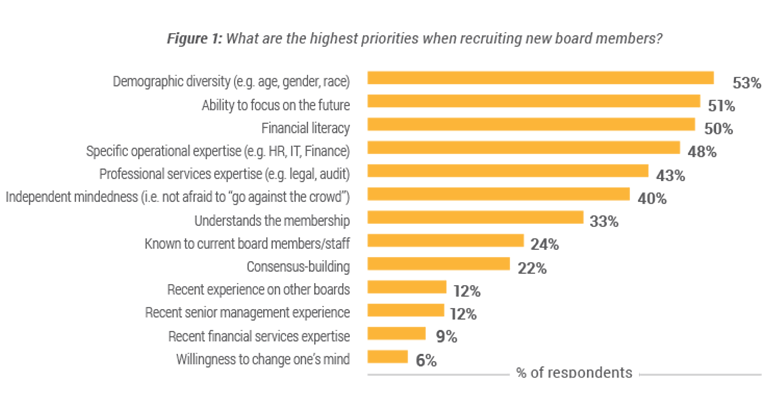6 minutes
The credit union and women’s movements are clearly doing something right. But we still have a long way to go.
The day after Kamala Harris was picked by Joe Biden as his running mate, I was talking with a colleague of mine about his choice. I have to note that the colleague in question is a woman, and she is about 10 years younger than me. She was lamenting that everyone in the media was focusing on the fact that Ms. Harris was a woman and, of course, a woman of color. From her point of view, as someone from a younger generation, why should this be the news? She sees Ms. Harris as a qualified, strong candidate for the position, regardless of her sex or ethnicity. In my colleague’s mind, of course she would have been in serious contention for the job.
It started me thinking about what my sister would say as someone who is 10 years older than me. She was in college in the ’70s, and I remember her then with long, straight hair, playing sad Joni Mitchell songs on her stereo and challenging my father, the minister, on nearly everything he said. She would bring with her the perspective of history: knowledge of the years when women struggled to have a voice in their marriages, let alone a seat in the boardroom, and of the racial struggles that plagued even my small hometown in rural Pennsylvania when she was in love with an African-American boy in high school.
Then my mind moved on to my niece. She is 10 years younger than my colleague. She’s a graduate of Stanford University, recently married to man whose parents immigrated from India, and studying to be a doctor at one of the best medical schools in the country—maybe the world (University of California-San Francisco).
Now, at this point, it should be noted that I write from a point of great advantage, and the cast of characters in this article also enjoy great advantages. We all hail from stable families, where shelter, food and love were plenty. We are all well-educated. We are all white.
So, what does this have to do with credit unions? And, specifically, with governance, since that’s my area of specialty?

I had two thoughts immediately after the conversation with my colleague and my ensuing reflections about my sister and niece. The first was around the notion of board renewal. We talk about the topic all the time at Quantum Governance, and we’re finding that credit union boards are increasingly talking about it, too. It used to be that credit union board members would join the board and stay for years—for decades, even. I’ve had a client who had two board members who served until they died in their 80s or 90s. Others explained odd behavior by noting that a few of their board members were displaying early signs of dementia.
And so, the first rule of board renewal is that you must renew, for the health of your board. It’s the board’s responsibility to ensure that you do.
The guiding principle for board renewal is to find a healthy balance of historical continuity and renewal. I celebrate that my colleague just assumes that Kamala Harris is right for the job of vice president and that my niece sees a horizon as wide as possible for herself and all those around her. (And I also imagine what will be available, once they are grown, to my great-nieces.)
But, it’s also critical for all of us, as women, to realize from whence we’ve come. My sister’s perspective is valuable, too. She reminded me recently that when she was growing up, girls were shut out completely from sports in high school, and today we have a woman coaching in the NFL. How far we have come, but still, how far we have to go…
Ensure that your board is balancing these perspectives—all of them. Historical continuity will give you important points of view on the past, and renewal will open future possibilities the likes of which you’ve never conceived.
The second thought that came to mind following the conversation with my colleague arose directly from the research that we published in The State of Credit Union Governance, 2020 report. For the first time ever, we found that demographic diversity was the No. 1 recruiting priority among credit union board members and leaders, surpassing financial literacy for the first time.

We also reported the news that the average credit union boards have nine members, three of which (36%) are women! On its face, this may not seem significant, but it is. In comparison, a 2018 study by Deloitte and The Alliance for Board Diversity of America of Fortune 100 companies found that women held only 25% of their board seats.
And in 2018, CUNA found that 52% of credit union CEOs are female, compared to only 5% in commercial banks and 6% in Fortune 500 companies. And it’s not just among the small credit unions: At credit unions with between $1 billion and $3 billion in assets, more than 14% of the CEOs were female, compared to just more than 3% of bank CEOs.
As a movement (both a credit union and a women’s movement), we’re clearly doing something right. But we still have a long way to go.
It seems that today, everyone is talking about “DEI” or diversity, equity and inclusion. (Note that Quantum Governance believes the appropriate order is “EDI,” given that the notion of equity is a broader concept that underlies both diversity and inclusion.) It’s a most worthy discussion, and it’s been a long time coming.
My biggest fear in all of the focus on DEI is that it will remain a discussion point and not become a point of action for us all. But clearly, we know how to do this. We’ve started to make true inroads in terms of integrating women into the boardrooms and C-suites of America—at least among our credit unions. Be sure not to let up on that focus. Rather, let’s add to it. While we can celebrate the gains made for women, we’ve not moved the needle one bit on increasing the number of visible minorities in the credit union boardroom or C-suite, and that’s just as important. In fact, remember, demographic diversity is now the No. 1 recruiting priority among credit union board members and leaders.
How much richer would your board be if 50% of its members were women? If you had true diversity in terms of ethnic and racial background? In terms of age and tenure? In terms of skills and experience? How much more stirring would the conversations in your boardroom be if you were truly open to listening to everyone’s voices? cues icon
Jennie Boden serves as Quantum Governance’s VP/strategic relationships and a senior consultant. Quantum Governance, Herndon, Virginia, is CUES’ strategic partner for governance services. Ms. Boden has 25+ years of experience in the national nonprofit sector and served as the chief staff officer for two nonprofits before coming to Quantum Governance.
Quantum Governance provides credit unions, corporations, nonprofits, associations and governmental entities with strategic, cost-effective governance, ethics and management consulting, facilitation and evaluation. With more than 50% of Quantum Governance’s clients representing credit unions, the organization fields more engagements in the credit union community than in any other. The organization is home to more strategic governance experience than any other practice in the country. The firm is a unique L3C organization that integrates the best elements of both the for- and non-profit communities into one practice. It is a low-profit, limited-liability service organization dedicated to the public good and one of the very first such legal hybrid organizations in the United States.






